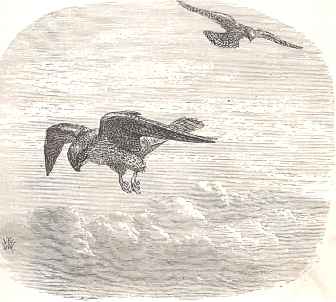
The Common Kestrel
|
It derives its name of Wind-hover from
its remarkable habit of hovering, head to windward, over some spot for
many minutes together. This action is always performed at a moderate distance
from the ground; some naturalists saying that the Hawk in question never
hovers at an elevation exceeding forty feet, while others, including the
writer and 19th century naturalist Reverend JG Wood, have seen the bird
hovering at a height of twice as many yards. Generally, however, it prefers
a lower distance, and is able by employing this manoeuvre to survey a tolerably
large space beneath. As its food consists in a very great measure of field-mice,
the Kestrel is thus able by means of its telescopic eyesight to see if
a mouse rises from its hole; and if it should do so, the bird drops on
it and secures it in its claws:
Unlike the sparrow-hawk, the Kestrel is
undoubtedly gregarious, and will build its nest in close proximity to the
habitations of other birds, a number of nests being often found within
a few yards of each other. The scholar HB Tristram remarks that he
has found its nest in the recesses of the caverns occupied by the griffon
vultures, and that the Kestrel also builds close to the eagles, and is
the only bird which is permitted to do so. It also builds in company with
the Jackdaw.
The Kestrel has a very large geographical range, being plentiful not only in England and Palestine, but in Northern
and Southern Europe, throughout the greater part of Asia, in Siberia, and
in portions of Africa. The bird, therefore, is capable of enduring both
heat and cold, and, as is often the case with those creatures that are
useful to man, is a perfect cosmopolitan.
The illustration is drawn from a sketch
taken from life. The bird hovered so near a house, and remained so long
in one place, that the artist fixed a telescope and secured an exact sketch
of the bird in the peculiar attitude which it is so fond of assuming. After
a while, the Kestrel ascended to a higher elevation, and then resumed its
hovering, in the attitude which is shown in the upper figure.
It is easily trained, and, although in
the old hawking days it was considered a bird which a noble could not carry,
it can be trained to chase the smaller birds as successfully as the falcons
can be taught to pursue the heron. The name Tinnunculus is supposed by
some to have been given to the bird in allusion to its peculiar cry, which
is clear, shrill, and consists of a single note several times repeated.
|





